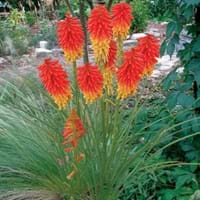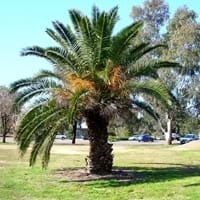Life Span
Perennial
Perennial
Type
Perennial
Palm or Cycad
Origin
Hybrid origin
Canary Islands
Types
Not Available
phoenix canariensis hybrid, Phoenix rupicola
Number of Varieties
Not Available
Habitat
Damp Places, Marshy ground
along watercourse, Fertile bottom land, Moist Soils, Volcanic Islands
USDA Hardiness Zone
6-9
8-13
Sunset Zone
2a, 2b, 3a, 3b, 4, 5, 6, 7, 8, 9, 14, 15, 16, 17, 18, 19, 20, 21, 22, 23, 24
H1, H2, 8, 9, 12, 13, 14, 15, 16, 17, 18, 19, 20, 21, 22, 23, 24
Habit
Clump-Forming
Upright/Erect
Flower Color
Yellow, Red, Orange, Pink
Yellow, Ivory
Flower Color Modifier
Bicolor
Bicolor
Fruit Color
Not Available
Yellow, Red
Leaf Color in Spring
Green, Blue Green
Blue Green, Dark Green
Leaf Color in Summer
Green, Blue Green
Blue Green, Dark Green
Leaf Color in Fall
Blue Green, Gray Green, Light Yellow
Blue Green, Dark Green
Leaf Color in Winter
Light Green
Blue Green, Gray Green, Dark Green
Leaf Shape
Linear
Palmate
Plant Season
Spring, Summer
Spring, Summer, Fall, Winter
Sunlight
Full Sun, Partial Sun
Full Sun, Partial Sun
Type of Soil
Clay, Loam, Sand
Loam, Sand
The pH of Soil
Acidic, Neutral
Acidic, Neutral, Alkaline
Soil Drainage
Well drained
Well drained
Bloom Time
Early Summer, Summer
Early Summer, Summer
Tolerances
Drought
Drought, Salt
Where to Plant?
Container, Ground
Ground, Pot
How to Plant?
Divison, Seedlings
Rooted stem cutting, Seedlings
Plant Maintenance
Medium
Medium
Watering Requirements
Needs more water during establishment, Water Deeply, Water in morning to avoid prompting diseases, Water in the early morning hours
Allow to dry out slightly between watering, Do Not over Water, Needs good drainage, Reduce watering in winter
In Summer
Lots of watering
Lots of watering
In Spring
Moderate
Moderate
In Winter
Average Water
Average Water
Soil pH
Acidic, Neutral
Acidic, Neutral, Alkaline
Soil Type
Clay, Loam, Sand
Loam, Sand
Soil Drainage Capacity
Well drained
Well drained
Sun Exposure
Full Sun, Partial Sun
Full Sun, Partial Sun
Pruning
Cut or pinch the stems, Remove damaged leaves, Remove dead branches, Remove dead leaves
Remove damaged leaves, Remove dead branches, Remove dead leaves
Fertilizers
All-Purpose Liquid Fertilizer, Apply N-P-K
All-Purpose Liquid Fertilizer
Pests and Diseases
Onion thrips, Red blotch, Root rot
Palmetto weevil
Plant Tolerance
Drought, Moisture
Drought
Flower Petal Number
Single
Single
Foliage Texture
Coarse
Coarse
Foliage Sheen
Matte
Glossy
Attracts
Snails
Not Available
Allergy
Not Available
Mild Allergen
Aesthetic Uses
Borders, Cottage Garden, Ground Cover
Cottage Garden, Formal Garden, Used in parkland
Beauty Benefits
Not Available
Not Available
Environmental Uses
Air purification
Air purification
Medicinal Uses
Not Available
Energy
Part of Plant Used
Not Available
Whole plant
Other Uses
Not Available
Air freshner, Food for insects, Used As Food
Used As Indoor Plant
No
Yes
Used As Outdoor Plant
Yes
Yes
Garden Design
Container, Cutflower, Mixed Border, Rock Garden, Wall
Feature Plant, Fruit / Fruit Tree, Street Trees, Tropical
Botanical Name
KNIPHOFIA 'Border Ballet'
PHOENIX canariensis
Common Name
Tritoma, Wisley Blue Spring Starflower, Wisley Blue Springstar
Canary Island Date Palm, canary date palm, dattier des Canaries, phoenix palm, pineapple palm
In Hindi
Tritoma
Phoenix Canariensis
In German
Tritoma
Phoenix Canariensis
In French
Tritoma
dattier des Canaries
In Spanish
tritoma
palmera canaria
In Greek
tritoma
Phoenix Canariensis
In Portuguese
Tritoma
Palmeira-das-canárias
In Polish
Tritoma
Daktylowiec kanaryjski
In Latin
Trytoma
Phoenix Canariensis
Phylum
Tracheophyta
Vascular plant
Class
Magnoliopsida
Liliopsida
Order
Asparagales
Arecales
Family
Liliaceae
Arecaceae
Clade
Angiosperms, Monocots
Angiosperms, Commelinids, Monocots
Tribe
Not Available
Phoeniceae
Subfamily
Not Available
Coryphoideae
Season and Care of Tritoma and Phoenix Canariensis
Season and care of Tritoma and Phoenix Canariensis is important to know. While considering everything about Tritoma and Phoenix Canariensis Care, growing season is an essential factor. Tritoma season is Spring and Summer and Phoenix Canariensis season is Spring and Summer. The type of soil for Tritoma is Clay, Loam, Sand and for Phoenix Canariensis is Loam, Sand while the PH of soil for Tritoma is Acidic, Neutral and for Phoenix Canariensis is Acidic, Neutral, Alkaline.
Tritoma and Phoenix Canariensis Physical Information
Tritoma and Phoenix Canariensis physical information is very important for comparison. Tritoma height is 45.70 cm and width 50.80 cm whereas Phoenix Canariensis height is 152.00 cm and width 910.00 cm. The color specification of Tritoma and Phoenix Canariensis are as follows:
Tritoma flower color: Yellow, Red, Orange and Pink
Tritoma leaf color: Green and Blue Green
Phoenix Canariensis flower color: Yellow and Ivory
- Phoenix Canariensis leaf color: Blue Green and Dark Green
Care of Tritoma and Phoenix Canariensis
Care of Tritoma and Phoenix Canariensis include pruning, fertilizers, watering etc. Tritoma pruning is done Cut or pinch the stems, Remove damaged leaves, Remove dead branches and Remove dead leaves and Phoenix Canariensis pruning is done Remove damaged leaves, Remove dead branches and Remove dead leaves. In summer Tritoma needs Lots of watering and in winter, it needs Average Water. Whereas, in summer Phoenix Canariensis needs Lots of watering and in winter, it needs Average Water.





